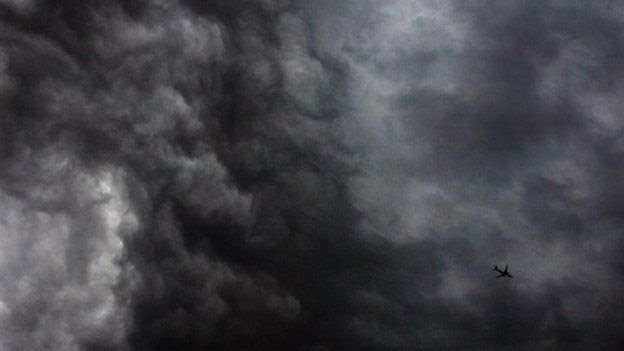AirAsia Flight QZ8501 was reported to have been navigating around large thunderclouds before it went missing, with reports suggesting the captain had asked for permission to take the plane higher.
According to Gloria Kulesa of the Federal Aviation Administration, the weather is a primary contributing factor in 23% of all aviation accidents – including both serious and minor – across the globe.
Wherever a plane has been lost in or near a storm there is always speculation about what part the weather might have played.
For instance, although it has not yet been established why Air Algerie Flight 5017 crashed in the Sahara in July, killing all 118 people on board, there had been reports of bad weather.

Search teams scoured the Java Sea for two days before Flight QZ8501 debris was found

The first vague sightings of objects in the sea quickly led to more discoveries
But it’s very rare for the weather alone to cause airliners to crash, experts say. Instead, how pilots and crew operate the plane mostly determines whether an incident will end up being a fatal accident, says Sylvia Wrigley, a light aircraft pilot and author of Why Planes Crash.
“I can’t think of an accident where weather was the sole cause of the problem,” she says. “But there can be a situation where the weather puts the aircraft at a higher risk of going wrong.”
Very powerful storms might be able to seriously damage the wings on a small aircraft but, typically, pilots and air traffic controllers make great effort to avoid them. Crews aim to fly at least 10 miles (16km) around the worst ones. Nose-mounted weather radar technology has made it far easier to detect – and thus steer away from – dangerous weather conditions.
Another crash where the weather was examined as a factor was the Air France plane lost in the Atlantic in 2009. After hitting turbulence, the pilots failed to discuss repeated stall warnings and did not have the training to deal with the situation, investigators found.

A build up of ice on the wings can cause problems, but pilots are trained to deal with it
A build-up of ice on the wings or tail can cause a plane to crash, but pilots are trained to avoid this. In addition, aircraft wings are fitted with “static wicks”, which dissipate the electricity from lightning strikes safely. It is estimated that each commercial airliner is struck once a year.
Heavy rain or sleet has also been known to cause “flameouts” – where the engine’s flame is extinguished. The engine can usually be restarted by the pilot but not always. A Garuda Indonesia Airways 737 plane experienced a double engine flameout during heavy rain over Java in 2002. Although the pilots were unable to restart the engines they managed to guide the plane down safely into a river.
It remains very unusual for accidents to be caused by pilots failing to deal with bad weather at high altitudes. The International Civil Aviation Organization (ICAO) says that more than half of all accidents between 2006-2011 were runway safety-related.
Credit: BBC report of 30 December 2014.






Leave a Reply